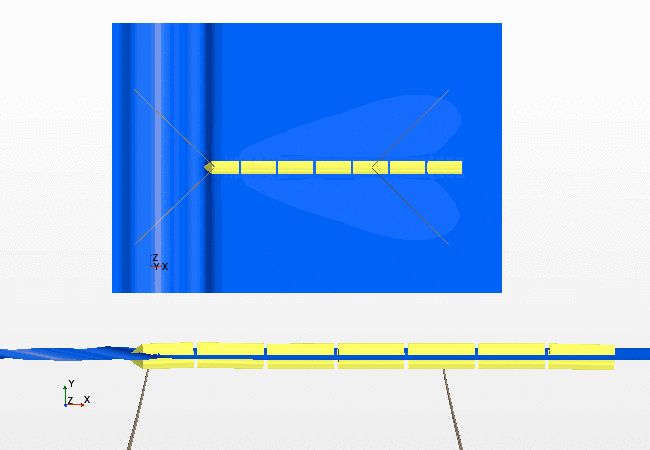Dynamic Fluid Body Interaction
Dynamic Fluid Body Interaction (DFBI) in Simcenter STAR-CCM+ allows you to simulate the motion of a 6-DOF body with the displacement and rotation resulting from the defined mechanical and multiphysics interaction (flow, DEM, solid stress, EMAG).
Within each time step, Simcenter STAR-CCM+ applies the resultant force and moment on the rigid body and solves the governing equations of motion to find the new position and orientation of the rigid body.
An example of floating DFBI bodies connected using spherical joints and fixed to the sea floor with mooring lines is shown below:

- 6-DOF Body (Rigid Body)
- A 6-DOF body in Simcenter STAR-CCM+ indicates a rigid body with motion calculated dynamically from a
variety of forces and moments acting on it.There are two types of 6-DOF body:
- Continuum Body: A continuum body is used for applications where the 6-DOF body is required to interact with flow and other physics in order to calculate forces and moments acting on it. You must create at least one continuum body in order to set up a DFBI simulation.
- Mechanical Body: A mechanical body is a rigid structure that has no interaction with flow or other physics (apart from the effect of gravity) and is used in cases where the flow interaction can be neglected. However, a mechanical body is still subject to external forces and moments, Body Couplings and Body Constraints.
For a 6-DOF body, it is sufficient to model the motion of a point of the body and the body's rotation about that point. In many cases, this point is simply the body's center of mass. The relative motion of any other part of the body can be determined from this. It is necessary to know the moments of inertia of the body about a reference point (which is normally the center of mass) before the rotational motion can be calculated.
A mechanical body has no volume mesh associated with it. Therefore, instead of selecting region boundaries, you specify geometry parts to represent the mechanical body in visualization scenes. The movement of the geometry parts associated to the mechanical body can be visualized through a DFBI Displayer. See also Setting up DFBI Post-Processing.
- External Forces and Moments
-
In the simulation tree, every 6-DOF body node exposes a collection of all the forces and moments applied to the body.
By default, the following force is activated:
- Gravity Force (for all bodies)
In addition, you can have the following forces and moments:
- Other Model Related Forces and Moments
- User-Defined Forces and Moments
- Body Coupling Forces
- Constraint Forces
For more details, refer to External Forces and Moments Reference and the Theory Guide section Forces and Moments.
- Body Couplings
- Through a body coupling you can connect two 6-DOF bodies as well as a 6-DOF body and the environment. For more details, refer to Body Couplings.
- Body Constraints
- Through a body constraint one or more degrees of freedom of a 6-DOF body are constrained. For more details, refer to Body Constraints.
- 6-DOF Solver
-
The 6-DOF Solver computes the motion of all 6-DOF bodies from resultant forces and moments. When accounting for fluid forces, pressure and shear forces are integrated over the surfaces of 6-DOF continuum bodies. For more details, refer to 6-DOF Solver Reference.
- DFBI Motion
-
DFBI motion is chosen to correctly move the mesh vertices surrounding a moving 6-DOF body. Different DFBI motions apply different strategies to move the mesh according to the body motion.
Simcenter STAR-CCM+ provides the following five DFBI motions:
- DFBI Rotation and Translation—This motion transmits both rotational and translational displacements from the 6-DOF body. By assigning this motion to a region, the region moves rigidly together with the 6-DOF body. For an example of setting up this type of motion, see Combining DFBI Motion with Overset, where the overset region moves with the 6-DOF body and the background region stays stationary.
- DFBI Morphing—This motion transmits both rotational and translational displacements from the 6-DOF body. When you assign this motion to a region, the region does not move rigidly with the 6-DOF body; instead, the mesh lines between a 6-DOF body and the outer region boundaries are morphed to realize the displacement of the 6-DOF body. To set up this type of motion, see Combining DFBI Motion with Morphing.
- DFBI Embedded Rotation—This motion requires one
inner and one outer region. The inner region, which includes the 6-DOF body, obtains
both rotational and translational displacements of the 6-DOF body. The outer region,
which is separated from the inner region by an overset or sliding interface, obtains
only the translational displacement of the 6-DOF body. Relative rotation therefore
exists between these two regions. For an example of setting up this type of motion
with sliding interface, see Using DFBI Embedded Motion with Sliding Interface.
To define additional motion associated to the 6-DOF body motion, refer to Body Motion, Follow Motion, and Superposing Motion.
- 6-DOF Motion Solver
-
The 6-DOF Motion Solver moves the vertices of the grid according to the chosen DFBI motion and the body motion calculated by the 6-DOF Solver.